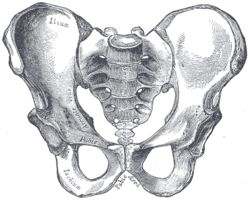

MedFriendly®


Pubis (Pubic Bone)
The pubis is one of a pair of two bones that form the
lower, front part of the hip. At birth, the pubis is its own
separate area, but later becomes fused (blended) with
the other two major hip bones, the ischium and the
ilium. As you can see from the picture above, the ilium
is the part of the hip located above and behind the
pubis. The ischium is the part of the hip that connects
with the lower part of the pubis. Together, the ilium,
ischium, and pubis bones all form the hips.
FEATURED BOOK: An Illustrated Guide to the Human Body and How It Works
The pubis bones are joined together at an area of tissue called the pubic symphysis,
which can also be seen in the picture above. Each pubis bone has a main body, a
superior (top) ramus, and an inferior (bottom) ramus. The word "ramus" is Latin for
"branch." The top branch of the pubis enters into and forms one fifth of the acetabulum.
The acetabulum is a cup-shaped depression on the surface of the hip bone that the top
of the leg connects with. The acetabulum can be seen in the picture above, which
allows you to see how nicely a leg would fit in this area. The bottom branch of the pubis
fuses (blends) with the ramus (branch) of the ischium to form an area known as the
ischiopubic ramus. The term "ischiopubic ramus" is just a fancy way to say "the branch
of the ischium and the pubis."
If you look at the picture above, you will see that there are two circular openings
between the top and bottom parts of the pubis. This opening is known as the obturator
foramen, which in Latin means "to close (a) hole."
"Where Medical Information is Easy to Understand"™
Another area of the pubis worth noting is the iliopectineal line, which
is a bony area that is present on the top surface of the pubis and on
the inner part of the ilium (see picture above).
There are many different types of muscles that are attached to the
pubis. Damage to the pubis can also cause damage to the muscles
and tissues described below. The outer surface of the pubis is
where the following muscles begin:
ADDUCTOR LONGUS: This muscle connects to the thigh and helps
it flex and adduct. To adduct is to move towards or past the center
of the body. The name of this muscle literally means "long adductor."
ADDUCTOR BREVIS: A triangle-shaped muscle that helps flex the leg as well as rotate and adduct (see
above) the leg to the middle of the body. This muscle begins at the outer surface of the lower branch of
the pubis. The name of this muscle literally means "short adductor."
GRACILIS: Part of this flat, thin muscle begins at the outer surface of the lower branch of the pubis and
goes to the thigh. It serves to adduct the thigh, flex the leg, and move the leg towards the middle of the
body after it is flexed. Gracilis literally means "scanty" (barely enough).
OBTURATOR EXTERNUS: A flat, triangle-shaped muscle that connects to the thigh, and helps rotate it to
the side. Part of this muscle begins at the outer surface of the lower branch of the pubis. The name of this
muscle literally means "to close outside."
The inner surface of the pubis is where the following muscles begin:
LEVATOR ANI: One of a pair of muscles that supports and slightly raises the soft tissues by the bottom of
the pelvis. Levator means "to lift up."
OBTURATOR INTERNUS: A muscle that begins at the inner surface of the lower branch of the pubis. This
muscle rotates the thigh to the side and extends and abducts it when it is flexed. To abduct is to move
away from the center. The name of this muscle literally means "to close inside."
Muscles also attach to a part of the pubis known as the pubic crest. The pubic crest is the rough, front
border of the body of the pubis. The following muscles and tissues attach to the pubic crest:
RECTUS ABDOMINUS: A pair of muscles of the belly that help push together the contents of the belly,
tense the front wall of the belly, and flex part of the bony covering of the spine. The name of this muscle
literally means "straight belly."
THE PYRAMIDALIS: A pair of muscles of the belly that tenses the linea alba (literally, the "white line"),
which is a white part of tissues in the middle line of the belly. Pyramidalis means "in the shape of a
pyramid."
INGUINAL FALX: The lower end part of a type of tissue in the lower area of the belly. The inguinal falx
serves to strengthen part of the front of the belly wall. The name of this tissue literally means "groin
sickle." A sickle is a type of curved, metal farming instrument.
Another muscle that attaches to the pubis (specifically, the lower branch of the pubis) is the adductor
magnus. The adductor magnus is a long, heavy, triangle-shaped muscle that helps rotate the thigh to the
middle and side of the body, extends the thigh, and flexes it onto the hip. The name of this muscle literally
means "large adductor." The pubis is also known as the os pubis and the pubic bone. Pubis comes from
the Latin word "pubes" meaning "groin."















